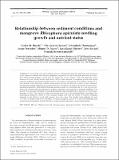Por favor, use este identificador para citar o enlazar a este item:
http://hdl.handle.net/10261/11108COMPARTIR / EXPORTAR:
 SHARE SHARE
 CORE
BASE CORE
BASE
|
|
| Visualizar otros formatos: MARC | Dublin Core | RDF | ORE | MODS | METS | DIDL | DATACITE | |

| Título: | Relationship between sediment conditions and mangrove Rhizophora apiculata seedling growth and nutrient status |
Autor: | Duarte, Carlos M. CSIC ORCID; Geertz-Hansen, Ole; Thampanya, Udomluck; Terrados, Jorge CSIC ORCID CVN ; Fortes, Miguel D.; Kamp-Nielsen, Lars; Borum, Jens; Boromthanarath, Somsak | Palabras clave: | SE Asia Mangrove growth Nutrient status Sediment nutrients Watershed size |
Fecha de publicación: | 17-dic-1998 | Editor: | Inter Research | Citación: | Marine Ecology Progress Series (MEPS) 175: 277-283 (1998) | Resumen: | The growth rate and nutritional status of Rhizophora apiculata seedlings were analyzed across mangrove stands with different sediment composition in The Philippines and Southern Thailand. Plant growth differed 10-fold and the production of new leaves, roots and branches varied between 50- and 100-fold across sites. Most (>60%) of the variance in mangrove growth rate across systems could be accounted for by differences in the nutrient concentration of the leaves, which was in turn related to the interstitial nutrient concentration and the silt plus clay content of the sediments. Nutrient-poor coarse sediments were characteristic of mangroves located in the mouths of rivers draining small watersheds, while sediments at the mouths of large rivers had high silt, clay, and nutrient contents, thus allowing the development of nutrient-sufficient, fast-growing R. apiculata seedlings. The growth of R. apiculata seedlings increased significantly when the plants grew adjacent to rivers draining areas >10 km2. The results provide evidence that growth of R. apiculata seedlings at the edge of the progressing mangrove forests is often nutrient limited, and that the extent of nutrient limitation depends on the delivery of silt and nutrients from the rivers. The coastal zones adjacent to small (<10 km2) drainage areas seem unsuitable to support adequate growth of R. apiculata seedlings, and afforestation programmes should, therefore, target mud flats adjacent to large rivers instead. | Descripción: | 7 pages, 4 figures. | Versión del editor: | http://dx.doi.org/10.3354/meps175277 | URI: | http://hdl.handle.net/10261/11108 | DOI: | 10.3354/meps175277 | ISSN: | 0171-8630 | E-ISSN: | 1616-1599 |
| Aparece en las colecciones: | (CEAB) Artículos (IMEDEA) Artículos |
Ficheros en este ítem:
| Fichero | Descripción | Tamaño | Formato | |
|---|---|---|---|---|
| m175p2771.pdf | 686,76 kB | Adobe PDF |  Visualizar/Abrir |
CORE Recommender
SCOPUSTM
Citations
43
checked on 03-abr-2024
WEB OF SCIENCETM
Citations
36
checked on 23-feb-2024
Page view(s)
452
checked on 23-abr-2024
Download(s)
1.320
checked on 23-abr-2024
Google ScholarTM
Check
Altmetric
Altmetric
NOTA: Los ítems de Digital.CSIC están protegidos por copyright, con todos los derechos reservados, a menos que se indique lo contrario.
